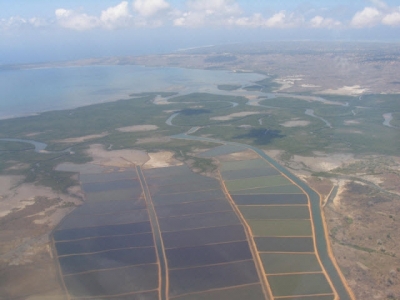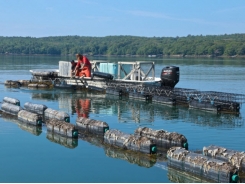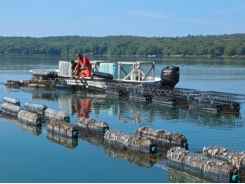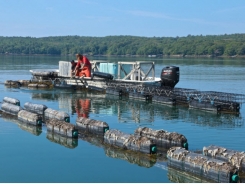What is biodiversity and its relevance to aquaculture certification?

Prof. Boyd: No single indicator can be used as a standard
The overarching theme of aquaculture certification is to avoid negative impacts of aquaculture on biodiversity, a widely-used word that may not be understood by all. Photo by Darryl Jory.
There has been much improvement in aquaculture production practices and environmental stewardship at aquaculture facilities over the past quarter-century. It is amazing how widespread participation in aquaculture certification programs has become. The overarching theme of aquaculture certification is to avoid negative impacts of aquaculture on biodiversity. But biodiversity is a widely used word that may not be understood by all.
Diversity in ecological systems
Diversity in ecological systems originally was a concept that could be defined simply as how individual organisms were distributed among the species. A greater ratio of total species present to the total number of individuals of all species present indicated greater diversity. This concept has been applied to biological communities (interacting species at a location), particular groups of animals or plants (birds, mammals, phytoplankton, etc.), or to entire ecosystems.
For example, suppose that two water bodies each had 20,000 individual phytoplankton organisms per milliliter, but one water body had 25 species of phytoplankton and the other had 5 species of phytoplankton. The water with the most species of phytoplankton has the greatest phytoplankton diversity. Many equations have been developed for estimating species diversity. A simple one that has been used for phytoplankton follows:
Applying the equation to the example above reveals that the water body with 25 species of phytoplankton has a phytoplankton species diversity of 2.42, while the other one with only 5 species of phytoplankton has a species diversity of 0.40.
Communities with high species diversity tend to be more stable than those with low diversity. This is because fluctuations in abundance of individual species have less influence on the structure and function of the entire community of species than do fluctuations in abundance of individual species in communities of lower diversity. Of course, the concept of diversity can be extended to an entire ecosystem, and the more species and the greater the array of taxonomic groups in an ecosystem, the more stable the ecosystem.
The benefit of diversity to ecosystem stability results from the fact that where there are many species, there usually will be more than one species carrying out particular functions, such as photosynthesis, foraging, preying, decomposing, etc. In other words, there is greater redundancy and resiliency in a more diverse ecosystem. Removal of a single species from an ecosystem would be more likely to negatively impact an ecosystem of low diversity than it would an ecosystem with greater diversity.

In ecological terms, systems with more species – like mangrove ecosystems – have greater redundancy of functions and resiliency. Photo by Darryl Jory.
Ecosystem biodiversity
The concept of diversity has been expanded to the concept of biodiversity of ecosystems. Ecosystems have unique geological, edaphic, hydrologic and climatic regimes that affect the types and abundance of species living in them. For example, an aquatic ecosystem is much different from a terrestrial ecosystem, but a nutrient-poor aquatic ecosystem also differs greatly from a nutrient-rich one.
It is generally accepted that tropical ecosystems are more diverse than ecosystems in temperate and cold climates. Invertebrate, plankton and bacterial communities tend to be more diverse than higher plant and vertebrate communities. Moreover, the species of organisms in an ecosystem all have genetic diversity, and the interaction of ecosystem diversity and genetic diversity results in gradual changes in the characteristics of organisms over time.
The new concept of biodiversity is so broad that it is almost impossible to find a suitable, single index of biodiversity. Although protection of biodiversity has become a theme in ecology and natural resource management, the term biodiversity does not have a single, widely accepted definition and it is extremely difficult to measure biodiversity.
The major factors that work to lessen biodiversity are as follows: deforestation and other land-use changes; overexploitation of species by hunting or fishing; introduction of exotic species that may be highly aggressive, competitive, or predaceous and for which there are no natural controls; introduction of new diseases with which one or more organisms have no resistance; pollution with organic matter, nutrients, or toxins; modification of gene pools by introduction or organisms that are genetically different from local organisms.
Possible effects of aquaculture on biodiversity
The best simple compilation of the possible effects of aquaculture on biodiversity that I have seen was made by Dr. James Diana of the University of Michigan. A slightly modified version of his list is provided (Table 1). Emissions to the atmosphere of carbon dioxide and other greenhouse gases associated with climate change, and sulfur dioxide and other substances with the potential to cause acidification result from aquaculture.
This concept of biodiversity is so complex that it would be impossible to find a single indicator of biodiversity to use as a standard in aquaculture certification. This is the reason why aquaculture certification programs have many standards and requirements. It is necessary to reduce the environmental impacts of all aspects of aquaculture production in order to avoid negative effects on biodiversity.
Related news
Tools

Phối trộn thức ăn chăn nuôi

Pha dung dịch thủy canh

Định mức cho tôm ăn

Phối trộn phân bón NPK

Xác định tỷ lệ tôm sống

Chuyển đổi đơn vị phân bón

Xác định công suất sục khí

Chuyển đổi đơn vị tôm

Tính diện tích nhà kính

Tính thể tích ao




 Why water mixing and movement is key in…
Why water mixing and movement is key in…  Maine oyster farmer stares down climate change, learns…
Maine oyster farmer stares down climate change, learns…